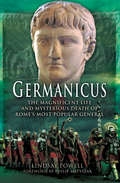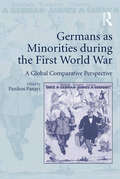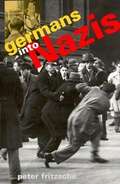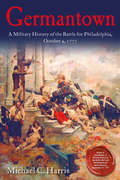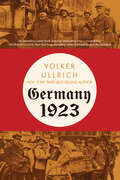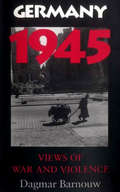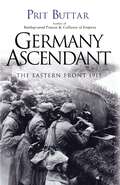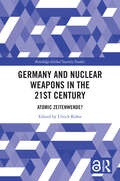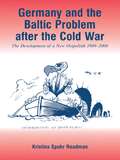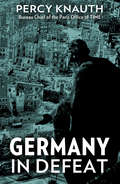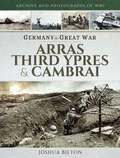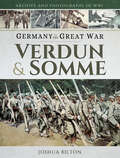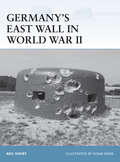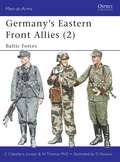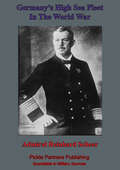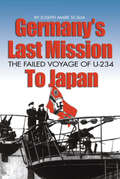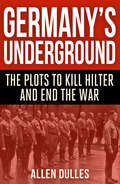- Table View
- List View
German-occupied Europe in the Second World War (Routledge Studies in Second World War History)
by Raffael Scheck Fabien Théofilakis Julia TorrieInspired by recent works on Nazi empire, this book provides a framework to guide occupation research with a broad comparative angle focusing on human interactions. Overcoming national compartmentalization, it examines Nazi occupations with attention to relations between occupiers and local populations and differences among occupation regimes. This is a timely book which engages in historical and current conversations on European nationalisms and the rise of right-wing populisms.
Germania: A Novel of Nazi Berlin
by Harald GilbersFrom international bestselling author Harald Gilbers comes the heart-pounding story of Jewish detective Richard Oppenheimer as he hunts for a serial killer through war-torn Nazi Berlin in Germania.Berlin 1944: a serial killer stalks the bombed-out capital of the Reich, preying on women and laying their mutilated bodies in front of war memorials. All of the victims are linked to the Nazi party. But according to one eyewitness account, the perpetrator is not an opponent of Hitler's regime, but rather a loyal Nazi. Jewish detective Richard Oppenheimer, once a successful investigator for the Berlin police, is reactivated by the Gestapo and forced onto the case. Oppenheimer is not just concerned with catching the killer and helping others survive, but also his own survival. Worst of all, solving this case is what will certainly put him in the most jeopardy. With no other choice but to futher his investigation, he feverishly searches for answers, and a way out of this dangerous game.
Germanicus: The Magnificent Life and Mysterious Death of Rome's Most Popular General
by Lindsay Powell&“The story of a Roman Emperor that might have been&” (Fighting Times). Germanicus was regarded by many Romans as a hero in the mold of Alexander the Great. His untimely death, in suspicious circumstances, ended the possibility of a return to a more open republic. This, the first modern biography of Germanicus, is in parts a growing-up story, a history of war, a tale of political intrigue, and a murder mystery. In this highly readable, fast paced account, historical detective Lindsay Powell details Germanicus&’s campaigns and battles in Illyricum and Germania; tracks him on his epic tour of the Eastern Mediterranean to Armenia and down the Nile; evaluates the possible causes of his death; and reports on the cruel fate his wife, Agrippina, and their children suffered at the hands of Praetorian Guard commander, and Tiberius&’s infamous deputy, Aelius Sejanus.
Germans as Minorities during the First World War: A Global Comparative Perspective
by Panikos PanayiOffering a global comparative perspective on the relationship between German minorities and the majority populations amongst which they found themselves during the First World War, this collection addresses how ’public opinion’ (the press, parliament and ordinary citizens) reacted towards Germans in their midst. The volume uses the experience of Germans to explore whether the War can be regarded as a turning point in the mistreatment of minorities, one that would lead to worse manifestations of racism, nationalism and xenophobia later in the twentieth century.
Germans into Nazis
by Peter FritzscheIn this dramatically plotted book, organized around crucial turning points in 1914, 1918, and 1933, Peter Fritzsche explains why the Nazis were so popular and what was behind the political choice made by the German people.
Germans to Poles
by Hugo ServiceAt the end of the Second World War, mass forced migration and population movement accompanied the collapse of Nazi Germany's occupation and the start of Soviet domination in East-Central Europe. Hugo Service examines the experience of Poland's new territories, exploring the Polish Communist attempt to 'cleanse' these territories in line with a nationalist vision, against the legacy of brutal wartime occupations of Central and Eastern Europe by Nazi Germany and the Soviet Union. The expulsion of over three million Germans was intertwined with the arrival of millions of Polish settlers. Around one million German citizens were categorised as 'native Poles' and urged to adopt a Polish national identity. The most visible traces of German culture were erased. Jewish Holocaust survivors arrived and, for the most part, soon left again. Drawing on two case studies, the book exposes how these events varied by region and locality.
Germantown: A Military History of the Battle for Philadelphia, October 4, 1777
by Michael C. HarrisThe award–winning author of Brandywine examines a pivotal but overlooked battle of the American Revolution’s Philadelphia Campaign.Today, Germantown is a busy Philadelphia neighborhood. On October 4, 1777, it was a small village on the outskirts of the colonial capital—and the site of one of the American Revolution’s largest battles. Now Michael C. Harris sheds new light on this important action with a captivating historical study.After defeating Washington’s rebel army in the Battle of Brandywine, General Sir William Howe took Philadelphia. But Washington soon returned, launching a surprise attack on the British garrison at Germantown. The recapture of the colonial capital seemed within Washington’s grasp until poor decisions by the American high command led to a clear British victory. With original archival research and a deep knowledge of the terrain, Harris merges the strategic, political, and tactical history of this complex operation into a single compelling account. Complete with original maps, illustrations, and modern photos, and told largely through the words of those who fought there, Germantown is a major contribution to American Revolutionary studies.
Germany 1923: Hyperinflation, Hitler's Putsch, And Democracy In Crisis
by Volker UllrichFrom the New York Times best-selling historian comes a gripping account of the crisis of the Weimar Republic, when hyperinflation and political upheaval threatened to unravel a new experiment in democracy. As the great Austrian writer Stefan Zweig confided in his autobiography, written in exile, “I have a pretty thorough knowledge of history, but never, to my recollection, has it produced such madness in such gigantic proportions.” He was referring to the situation in Germany in 1923. It was a “year of lunacy,” defined by hyperinflation, a political system on the verge of collapse, and separatist movements that threatened Germany’s territorial integrity. Most significantly, Adolf Hitler launched his infamous Beer Hall Putsch in Munich—a failed coup that nonetheless drew international attention and demonstrated the Nazis’ ruthless determination to seize power. In Germany 1923, award-winning historian Volker Ullrich draws on letters, memoirs, newspaper articles, and other sources from the time to present a captivating new history of those explosive twelve months. The crisis began when the French invaded the Ruhr Valley in January to force Germany to pay the reparations it owed under the Treaty of Versailles, which had ended the Great War. For years, German leaders had embraced inflationary policies to finance the costs of defeat, and, as Ullrich demonstrates, the invasion utterly destroyed the value of the German mark. Before the war, the exchange rate was 4.2 marks to the dollar. By November 20, 1923, a dollar was worth an incomprehensible 4.2 trillion marks, and a loaf of bread cost 200 billion. Facing the abyss, many ordinary Germans called for a national messiah. Among the figures to vie for that role was Hitler, a thirty-four-year-old veteran who possessed a uniquely malevolent personal magnetism. Although the Nazi coup in November was put down and Hitler arrested, the putsch showed just how tenuous the first German democracy, the Weimar Republic, was at its core. As Ullrich’s panoramic narrative reveals, other Germans responded to the successive crises by launching a cultural revolution: 1923 witnessed the emergence of a multitude of new movements, from Dada to Bauhaus, and of such iconoclasts as Bertolt Brecht, George Grosz, and Franz Kafka. Yet most observers were amazed that the Weimar Republic was able to survive, and the more astute realized that the feral undercurrents unleashed could lead to much worse. Publishing a century after that fateful year, Germany 1923 is a riveting chronicle of one of the most challenging times any modern democracy has faced, one with haunting parallels to our own political moment.
Germany 1945: Views of War and Violence
by Dagmar Barnouw&“Packed with carefully chosen photos . . . this book is a moving reminder of the material and moral devastation left behind by Nazi Germany.&” ―Rudy Koshar, University of Wisconsin–Madison The Allied forces that entered Germany at the close of World War II were looking for remorse and open admissions of guilt from the Germans. Instead, they saw arrogance, servility, and a population thoroughly brainwashed by Nazis. But photos from the period tell a more complex story. In fact, Dagmar Barnouw argues that postwar Allied and German photography holds many possible clues for understanding the recent German past. A significant addition to the scholarship on postwar German culture and political identity, this book makes an important contribution to the current discussion of German memory. &“Provocative, brilliant, and unsettling.&” —Washington Times &“[Barnouw&’s] thoughtful analysis of a large assortment of photographs . . . allows Barnouw to look at how and not just what people saw, and to bring that perspective into conversation with the historical debates about the war&’s end in Germany.&” —Journal of Contemporary History) &“[Barnouw&’s] work shows that perspective plays a key role both in photography and in trying to master Germany&’s past. [F]ascinating.&” —Library Journal
Germany Ascendant
by Prit ButtarWhile millions of men died in France and Belgium in 1915, battles equally as large and bloody were being fought on the Eastern Front, as Imperial Germany, Hapsburg Austria-Hungary, and Tsarist Russia clashed on a scale greater than anything seen on the Western Front. These massive offensives were shocking in their scale and intensity, and hugely important. Yet they are largely ignored in the West. Now, with the work of internationally renowned Eastern Front expert Prit Buttar, this story of the unknown side of World War I is finally being told.In Germany Ascendant, Buttar examines the critical year of 1915, when Germany launched the great Gorlice-Tarnow Offensive, lead by Field Marshal Mackensen. The move, which started as a minor German operation to relieve their Austro-Hungarian allies, ultimately resulted in the utter collapse of Russian forces from all of Poland and Gallacia, and came tantalizingly close to knocking Russia out of the war altogether. Next the Germans led the invasion of Serbia, leading Britain and France to intervene with ground troops, an operation that ultimately failed. Yet despite this unbroken string of successes, Germany was still hamstrung by a two-front war. Her every attempt to knock Russia out of the war--military and diplomatic--has failed. The stage was then set for the next phase of the war when Russia launched its own counter-offensive that nearly brought the Central Powers to their knees.
Germany and Nuclear Weapons in the 21st Century: Atomic Zeitenwende? (Routledge Global Security Studies)
by Ulrich KühnThis book is the first scholarly book to take a comprehensive look at Germany’s nuclear weapons policies in the 21st century.German foreign and security policy is facing a profound reorientation. Great power competition between the United States and both a revanchist Russia and a rising China, the return of war and nuclear threats to Europe, and the emergence of new technologies all force Germany to adapt. German policymakers and scholars increasingly speak of a pivotal Zeitenwende, an epochal turning point in history. How does Germany adapt its nuclear policies to these changing conditions?The volume brings together internationally renowned nuclear scholars and policy analysts from Germany and abroad. Focussing on German nuclear deterrence, arms control and disarmament as well as nonproliferation policies, the contributors assess how German leaders have navigated continuity and change, domestically and abroad. The volume concludes that Germany remains bound by dependence on the United States and its own conservatism. Within these parameters, German leaders have adapted slowly to change and continue to balance seemingly contradictory deterrence and disarmament goals.This book will be of much interest to students of nuclear proliferation, security studies, German politics and International Relations, as well as policymakers.
Germany and the Baltic Problem After the Cold War: The Development of a New Ostpolitik, 1989-2000
by Kristina Spohr ReadmanThe root question this book addresses is how the new Germany will use its re-found status as a great power. Does Germany - as in the past - aim to dominate Europe? Or has it renounced its imperial ambitions following the trauma of division during the Cold War?In seeking answers to these questions, Kristina Spohr Readman scrutinises the development of Germany's new Ostpolitik (eastern policy) in the period 1989-2000. Against the background of recent European history, she analyses the re-establishment of a special relationship between Bonn/Berlin and Moscow. In particular, she assesses the peculiar geopolitical situation of the Baltic states: caught between a turbulent Russia in the east and a unified Germany in the west. The Baltic case reveals the complexities of a post-Cold War European security architecture in the making.
Germany in Defeat
by Pierre Van Paassen Percy KnauthGermany in Defeat, first published in 1946, is the first hand, detailed account of Germany at the end of World War Two by Time correspondent Percy Knauth. The book details Knauth's travels across the war-ravaged country: from Berlin to concentration camps including Buchenwald and Salispilz, from Hitler's bunker to his mountain retreat (the Berghof at Berchtesgaden), and his interviews with German, American, and Russian military officials and German civilians. His visit to Hitler's underground bunker in Berlin just days after Hitler committed suicide is a fascinating story, and his description of Buchenwald provides a unique, chilling look at the conditions and workings of the Nazi death camp.Percy Knauth, an American who attended school in Germany, worked first for the Chicago Tribune in Berlin, then for the New York Times. In 1942, he was the Paris Bureau Chief for Time magazine, and spent the next 28 years working for Time-Life publications in Paris, Berlin and New York. He retired as European editor in 1970 to devote his time to writing. Knauth died in 1995 at the age of 80.
Germany in the Great War: Arras, Third Ypres & Cambrai (Germany In The Great War Ser.)
by Joshua BiltonThis book documents the experiences of the Central Powers, specifically Austria-Hungary, Germany and the Ottoman Empire during 1917, as they fought on land, at sea and in the air. Drawing on hundreds of contemporary photographs, many of them never previously published, this book examines the experiences of these three nations, spotlighting not only the events that occurred throughout the year, but the lives of those individuals fighting and dying to defend their homelands, families and friends. Each chapter includes a succinct overview of a single front or theatre of operation, complimenting the hundreds of professional and amateur photographs contained within. Though many of the images are of the German and Austro-Hungarian armies on the Westfront and Ostfront, several additional chapters also explore the fighting across other, lesser-known fronts, including the Südwest Front and in Sinai and Palestine, and Mesopotamia. This book is an excellent pictorial guide that would be of benefit to anyone seeking to gain a better understanding of what life was like from the perspective of the German, Austro-Hungarian and Ottoman armies, and their peoples during the fourth year of the First World War.
Germany in the Great War: Verdun & Somme (Germany In The Great War Ser.)
by Joshua BiltonFor the Central Powers, 1916 was a year of trial and error, of successes and failures, of innovation and of drastic changes. Tactics developed, while war aims mutated to suit the inertia of trench warfare. Advances were effectively countered with the development of new weaponry, or indeed aided by their inclusion. Across all fronts, whether at home or in Poland, citizens and soldiers alike stood fast against Entente forces. On the Western Front, bitter fighting continued apace. To the east the armies of Austro-Hungary, Germany and Bulgaria battled Entente forces. Meanwhile at sea, the German High Seas Fleet ambushed the Royal Navy off the coast of Denmark. On the Home Front, the poor harvest of 1916, coupled with a lack of transport, led to a winter of stark deprivation. As a consequence, the German government introduced what was effectively a system of rationing entitled, ‘sharing scarcity.’ While to the south, Ottoman forces fought Allied soldiers for control of Kut and Erzurum, a fortified trading port in eastern Turkey. Germany in the Great War: Verdun & Somme is the third publication in a five-part series. In addition to the author’s introduction and a chronology of events, five hundred contemporary photographs, many of which have never before been published in this country, are included.
Germany's Drive to the West (Drang Nach Westen): A Study of Germany's Western War Aims during the First World War
by Hans W. GatzkeOriginally published in 1950. Hans Gatzke analyzes Germany's ambitions to expand westward during World War I. Germany's wartime plans for expansion to the west had important repercussions at home and abroad. Gatzke proceeds chronologically, starting with the German political parties' outlining of their war aims. Gatzke claims that a combination of interests, including those of industrialists, pan-Germans, the parties of the Right, and the Supreme Command was responsible for the stubborn propagation of Germany's large war aims, which condemned the German people to remain at war until the bitter end. Each of these forces had its own particular reasons for wanting to hold out for far-reaching territorial gains, yet one aim that most of them had in common was ensuring, through a successful peace settlement, the continuation of the existing order, to their own advantage and to the political and economic detriment of the majority of the German people.
Germany's East Wall in World War II
by Adam Hook Neil ShortThe East Wall was where the final battles for the stricken Third Reich were fought, amid scenes of utter carnage. Beginning life at the end of World War I, the wall became a pet project of Adolf Hitler's, whose ascent to power saw building work accelerated, with plans for a grand, 'Maginot-style' defence put in place. But with a characteristically erratic change of heart, Hitler began to systematically strip the wall of its best defensive assets to bolster the Atlantic Wall, never dreaming that he would face an attack on two fronts. Despite belated and somewhat bungled reinforcements later in the War, the Eastern Wall would face a monstrous challenge as it became the Reich's last redoubt in the face of the mighty Soviet war machine. Neil Short brings his expert knowledge to bear with an analysis of different stages of the wall's construction, the years of neglect and decay and the hasty, drastic redevelopment in the face of the looming Soviet threat.
Germany's Eastern Front Allies
by Nigel Thomas Darko PavlovicThe Baltic nations - Estonia, Latvia and Lithuania - enjoyed a brief independence between the World Wars before being annexed by the USSR in 1940 during World War II. The grim experience of Soviet occupation made it inevitable that after the German invasion of Russia in 1941 they would fight beside the Wehrmacht as allies against the Red Army while always hoping for restored independence. That hope was crushed again in 1944-45; yet 'Forest Brother' guerrillas continued to fight against hopeless odds for years after the second Soviet occupation. This extraordinary story is illustrated here with rare photos, insignia charts, tables of units and detailed uniform plates.
Germany's High Sea Fleet In The World War (Barnes and Noble Digital Library)
by Anon. Admiral Reinhard ScheerIncludes 26 illustrations, battle maps and portraits of the Naval War 1914-1918Known to his own sailors as the "Man with the Iron Mask", Admiral Reinhard Scheer was a hardened dedicated sailor. It was his relentless drive that enabled him to overcome his limited social background and gain the highest rank in the Kaiserliche Marine. His memoirs are of great interest to historians of the First World War and the nascent German 'Great Power' status.Broadly divided into three sections, the first part of his memoirs concentrates on the German Fleet's activities during the first years of the war, including the bombardment of the coast of Britain, which came as such a shock to the Allies. The second, which naturally dominates his memoirs, are his great exploits at the Battle of Jutland or Skaggerak in command of the cruiser squadron which caused such damage to the British Fleet. The third and final part recounts his time as chief of staff of the German Navy, as an advocate of unrestricted Naval Warfare he recounts his lobbying of the Emperor and the methods and experiences of the U-Boats under his command.A thoroughly gripping Naval read.Author -- Admiral Reinhard Scheer (1863-1928)Translator -- Anon.Text taken, whole and complete, from the edition published in New York [etc.] Cassell and company, ltd., 1920.Original Page Count - xiv and 375 pages.
Germany's High Sea Fleet in the World War
by Reinhard ScheerAnglo-German naval rivalry before 1914 had been expected to culminate in a cataclysmic fleet action in the North Sea once war was declared, a battle upon which the outcome of the war would depend: yet the two fleets met only once, at Jutland in 1916, and the battle was far from conclusive. In his own account of the war in the North Sea, first published in 1920, Admiral Scheer, the German commander at Jutland, gives his own explanation for the failure of either fleet to achieve the decisive victory expected of it, particularly the failure of his own operation plans that resulted in the battle of Jutland. This book is an invaluable account of one of the most important theatres of the First World War, written by one of its most senior commanders.
Germany's Last Mission to Japan
by Joseph Mark ScaliaWhen U-234 slipped out of a Norwegian harbor on her maiden voyage in March 1945, the submarine carried a precious assortment of armaments and a select group of officials destined for Japan. En route came word that Germany had surrendered, and the boat's commander, Johann Heinrich Fehler, suddenly found himself in a rogue submarine. U-234 was not only loaded with the most technically advanced weaponry and electronic detection devices of the era, but also two Japanese naval officers still at war with the Allies who preferred death to surrender. This dramatic account of the fateful voyage offers an intriguing look at the individuals involved. Until now, the legacy of U-234 has centered on her ominous cargo, including 560 kilograms of uranium oxide, the presence of which has been the focus of countless theories and conjecture.With this book Joseph Mark Scalia argues that the submarine's value lies not in her inanimate cargo but in the individuals accompanying the material to Japan. Through exhaustive research into U.S. Navy interrogation records, European and Japanese archives, and interviews with former U-234 crewmembers and other principals, Scalia has produced a fascinating portrait of proud warriors coping with defeat. Among them was a high-ranking naval judge sent to Tokyo to purge the residual elements from an infamous spy ring, an anti-aircraft and air defense expert, a top naval construction engineer, a radar expert, a Messerschmitt designer who later became project manager for the F-105 Thunderchief, and a Luftwaffe general who directed the 1939 aerial blitz of Poland and was implicated in the 1944 plot to assassinate Hitler.Because this is the first book to be solely devoted to U-234, it also provides a thorough examination of the 1600-ton Type XB minelaying submarine, from launch to surrender on 15 May 1945 to an American destroyer. In addition, the work evaluates the technology carried aboard--an actual ME-262 fighter and masking measures for submarines were included--and places the mystery of the uranium oxide cargo in perspective.
Germany's Underground
by Allen DullesGermany's Underground, first published in 1947, is the classic inside look at German resistance movements attempting to overthrow Adolph Hitler and the Nazi regime. Author Allen Dulles, younger brother of John Foster Dulles, was the OSS chief of station in Bern Switzerland, and had extensive personal contacts with members of the German underground. Following the war's end, he was stationed in Germany, providing him with access to captured secret Nazi documents. He was also able to interview the handful of surviving men and women involved in attempts to overthrow the Nazis or assassinate Hitler. Germany's Underground is a fascinating look at the individuals involved in the German resistance as well as an examination of morality and ethics in the midst of a brutal police state. Allen Dulles was appointed director of the U.S. CIA in 1953, a position he held until 1961. Dulles, born in 1893, passed away in 1969.
Germany's War and the Holocaust: Disputed Histories
by Omer BartovWhile attempts to come to terms with past catastrophe . . . can help prevent its recurrence, they may also provide arguments for . . . actions against the real or imagined perpetrators of previous disasters. The confrontation with . . . catastrophe can help us understand the roots and nature of this century's destructive urges, as well as humanity's extraordinary recuperative capacities; but it can also legitimize the perpetuation of violence and aggression. -from the Introduction Omer Bartov, a leading scholar of the Wehrmacht and the Holocaust, provides a critical analysis of various recent ways to understand the genocidal policies of the Nazi regime and the reconstruction of German and Jewish identities in the wake of World War II. Germany's War and the Holocaust both deepens our understanding of a crucial period in history and serves as an invaluable introduction to the vast body of literature in the field of Holocaust studies. Drawing on his background as a military historian to probe the nature of German warfare, Bartov considers the postwar myth of army resistance to Hitler and investigates the image of Blitzkrieg as a means to glorify war, debilitate the enemy, and hide the realities of mass destruction. The author also addresses several new analyses of the roots and nature of Nazi extermination policies, including revisionist views of the concentration camps. Finally, Bartov examines some paradigmatic interpretations of the Nazi period and its aftermath: the changing American, European, and Israeli discourses on the Holocaust; Victor Klemperer's view of Nazi Germany from within; and Germany's perception of its own victimhood.
Germany, Poland and the Common Security and Defence Policy
by Laura ChappellA comparative analysis of an old and new EU Member State's perceptions of and contributions to EU security and defence. This book focuses on change and continuity in both countries' defence policies and where convergence and divergence has occurred. This has important implications for the EU's effectiveness as an international security actor.
Germany, Poland, and Postmemorial Relations
by Kristin Kopp Joanna NiżyńskaCovering the period following the collapse of communism, the unification of Germany, and Poland's accession to the EU, this collection focuses on the interdependencies of German, Polish, and Jewish collective memories and their dialogic, transnational character, showing the collective nature of postmemory and the pressures that shape it.


